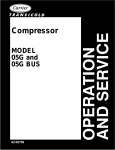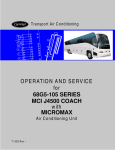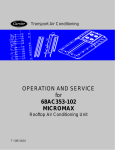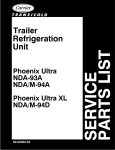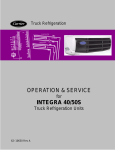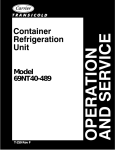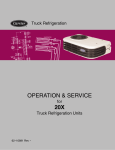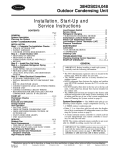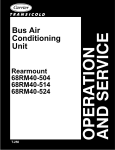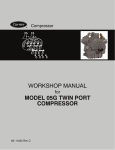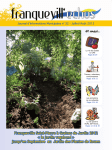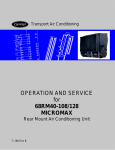Download Compressor - North America Transport Air Conditioning
Transcript
Compressor MODEL 05K 62-02491-02 OPERATION AND SERVICE MANUAL MODEL 05K COMPRESSOR Carrier Transicold Division, Carrier Corporation, P.O. Box 4805, Syracuse, N.Y. 13221 U. S. A. Carrier Transicold E.T.O. Boite Postale Nr. 16 Franqueville --- Saint--- Pierre 76520 Boos, FRANCE Carrier Corporation 1995 D Printed in U. S. A. 0795 TABLE OF CONTENTS Section 1 1.1 1.2 1.3 1.4 Page DESCRIPTION . . . . . . . . . . . . . . . . . . . . . . . . . . . . . . . . . . . . . . . . . . . . . . . . . . . . . . . . . Introduction . . . . . . . . . . . . . . . . . . . . . . . . . . . . . . . . . . . . . . . . . . . . . . . . . . . . . . . . . . . . General Description . . . . . . . . . . . . . . . . . . . . . . . . . . . . . . . . . . . . . . . . . . . . . . . . . . . . . . Compressor Reference Data . . . . . . . . . . . . . . . . . . . . . . . . . . . . . . . . . . . . . . . . . . . . . . . Detailed Description . . . . . . . . . . . . . . . . . . . . . . . . . . . . . . . . . . . . . . . . . . . . . . . . . . . . . 1.4.1 Suction and Discharge Valves . . . . . . . . . . . . . . . . . . . . . . . . . . . . . . . . . . . . . . . 1.4.2 Suction & Discharge Service Valves . . . . . . . . . . . . . . . . . . . . . . . . . . . . . . . . . . 1.4.3 Lubrication System . . . . . . . . . . . . . . . . . . . . . . . . . . . . . . . . . . . . . . . . . . . . . . . . Compressor Unloader . . . . . . . . . . . . . . . . . . . . . . . . . . . . . . . . . . . . . . . . . . . . . . . . . . . . 1.5.1 Hot Gas Bypass Unloader . . . . . . . . . . . . . . . . . . . . . . . . . . . . . . . . . . . . . . . . . 1.5.2 Suction Cutoff Unloader . . . . . . . . . . . . . . . . . . . . . . . . . . . . . . . . . . . . . . . . . . . 1.5.3 Pressure---Operated Unloaders . . . . . . . . . . . . . . . . . . . . . . . . . . . . . . . . . . . . . 1-1 1-1 1-1 1-1 1-3 1-3 1-3 1-3 1-3 1-4 1-5 1-6 2 2.1 2.2 COMPRESSOR REPLACEMENT . . . . . . . . . . . . . . . . . . . . . . . . . . . . . . . . . . . . . . . . . Compressor Removal . . . . . . . . . . . . . . . . . . . . . . . . . . . . . . . . . . . . . . . . . . . . . . . . . . . . . Compressor Replacement . . . . . . . . . . . . . . . . . . . . . . . . . . . . . . . . . . . . . . . . . . . . . . . . . 2.2.1 Installing Compressor Unloaders . . . . . . . . . . . . . . . . . . . . . . . . . . . . . . . . . . . . 2.2.2 Installing Compressor . . . . . . . . . . . . . . . . . . . . . . . . . . . . . . . . . . . . . . . . . . . . . 2-1 2-1 2-1 2-1 2-2 3 3.1 3.2 3.3 3.4 COMPRESSOR MAINTENANCE . . . . . . . . . . . . . . . . . . . . . . . . . . . . . . . . . . . . . . . . . . Introduction . . . . . . . . . . . . . . . . . . . . . . . . . . . . . . . . . . . . . . . . . . . . . . . . . . . . . . . . . . . . Inspection and Preparation for Reassembly . . . . . . . . . . . . . . . . . . . . . . . . . . . . . . . . . . Cylinder Head and Valve Plate . . . . . . . . . . . . . . . . . . . . . . . . . . . . . . . . . . . . . . . . . . . . . Oil Pump and Bearing Head . . . . . . . . . . . . . . . . . . . . . . . . . . . . . . . . . . . . . . . . . . . . . . 3.4.1 Low Profile Gear Pump . . . . . . . . . . . . . . . . . . . . . . . . . . . . . . . . . . . . . . . . . . . . 3.4.2 Gear Pump . . . . . . . . . . . . . . . . . . . . . . . . . . . . . . . . . . . . . . . . . . . . . . . . . . . . . . 3.4.3 Vane Pump . . . . . . . . . . . . . . . . . . . . . . . . . . . . . . . . . . . . . . . . . . . . . . . . . . . . . . Shaft Seal . . . . . . . . . . . . . . . . . . . . . . . . . . . . . . . . . . . . . . . . . . . . . . . . . . . . . . . . . . . . . . . Compressor Running Gear Removal . . . . . . . . . . . . . . . . . . . . . . . . . . . . . . . . . . . . . . . . Compressor Running Gear Reassembly . . . . . . . . . . . . . . . . . . . . . . . . . . . . . . . . . . . . . . Suction Strainer . . . . . . . . . . . . . . . . . . . . . . . . . . . . . . . . . . . . . . . . . . . . . . . . . . . . . . . . . Adding Oil . . . . . . . . . . . . . . . . . . . . . . . . . . . . . . . . . . . . . . . . . . . . . . . . . . . . . . . . . . . . . . Installing Compressor . . . . . . . . . . . . . . . . . . . . . . . . . . . . . . . . . . . . . . . . . . . . . . . . . . . . 3-1 3-1 3-1 3-1 3-2 3-2 3-3 3-4 3-5 3-6 3-7 3-8 3-8 3-8 1.5 3.5 3.6 3.7 3.8 3.9 3.10 i LIST OF ILLUSTRATIONS Figure Page 1-1 1-2 1-3 1-4 1-5 1-6 1-7 1-8 1-9 1-10 Model 05K Compressor . . . . . . . . . . . . . . . . . . . . . . . . . . . . . . . . . . . . . . . . . . . . . . . . . Suction & Discharge Valve . . . . . . . . . . . . . . . . . . . . . . . . . . . . . . . . . . . . . . . . . . . . . . . Oil Pump . . . . . . . . . . . . . . . . . . . . . . . . . . . . . . . . . . . . . . . . . . . . . . . . . . . . . . . . . . . . . . Compressor Unloader --- Hot Gas Bypass . . . . . . . . . . . . . . . . . . . . . . . . . . . . . . . . . . Compressor Cylinder Head Unloaded --- Hot Gas Bypass . . . . . . . . . . . . . . . . . . . . . Compressor Cylinder Head Loaded --- Hot Gas Bypass . . . . . . . . . . . . . . . . . . . . . . . Compressor Cylinder Head (Unloaded) --- Suction Cutoff . . . . . . . . . . . . . . . . . . . . Compressor Cylinder Head (Loaded) --- Suction Cutoff . . . . . . . . . . . . . . . . . . . . . . Pressure-Operated Unloader Loaded Operation . . . . . . . . . . . . . . . . . . . . . . . . . . . . Pressure-Operated Unloaded Unloaded Operation . . . . . . . . . . . . . . . . . . . . . . . . . . 1-2 1-3 1-3 1-4 1-4 1-5 1-5 1-6 1-6 1-6 2-1 Removal of Piston Plug . . . . . . . . . . . . . . . . . . . . . . . . . . . . . . . . . . . . . . . . . . . . . . . . . . 2-1 3-1 3-2 3-3 3-4 3-5 3-6 3-7 3-8 3-9 3-10 3-11 3-12 3-13 3-14 3-15 3-16 3-17 3-18 Cylinder Head & Valve Plate . . . . . . . . . . . . . . . . . . . . . . . . . . . . . . . . . . . . . . . . . . . . . Installing Suction Valves . . . . . . . . . . . . . . . . . . . . . . . . . . . . . . . . . . . . . . . . . . . . . . . . . Checking Suction Valve . . . . . . . . . . . . . . . . . . . . . . . . . . . . . . . . . . . . . . . . . . . . . . . . . . Oil Pump and Bearing Head Assembly . . . . . . . . . . . . . . . . . . . . . . . . . . . . . . . . . . . . . Low Profile Gear Oil Pump . . . . . . . . . . . . . . . . . . . . . . . . . . . . . . . . . . . . . . . . . . . . . . Gear Oil Pump . . . . . . . . . . . . . . . . . . . . . . . . . . . . . . . . . . . . . . . . . . . . . . . . . . . . . . . . . Vane Oil Pump . . . . . . . . . . . . . . . . . . . . . . . . . . . . . . . . . . . . . . . . . . . . . . . . . . . . . . . . Clutch (Bus & Rail) . . . . . . . . . . . . . . . . . . . . . . . . . . . . . . . . . . . . . . . . . . . . . . . . . . . . . Shaft Seal . . . . . . . . . . . . . . . . . . . . . . . . . . . . . . . . . . . . . . . . . . . . . . . . . . . . . . . . . . . . . Shaft Seal Removal . . . . . . . . . . . . . . . . . . . . . . . . . . . . . . . . . . . . . . . . . . . . . . . . . . . . . Seal End Cover Removal . . . . . . . . . . . . . . . . . . . . . . . . . . . . . . . . . . . . . . . . . . . . . . . . Piston Rings Removed . . . . . . . . . . . . . . . . . . . . . . . . . . . . . . . . . . . . . . . . . . . . . . . . . . Connecting Rod, Piston, and Pin . . . . . . . . . . . . . . . . . . . . . . . . . . . . . . . . . . . . . . . . . . Contoured Piston . . . . . . . . . . . . . . . . . . . . . . . . . . . . . . . . . . . . . . . . . . . . . . . . . . . . . . . Piston Rings . . . . . . . . . . . . . . . . . . . . . . . . . . . . . . . . . . . . . . . . . . . . . . . . . . . . . . . . . . . Installing Pistons . . . . . . . . . . . . . . . . . . . . . . . . . . . . . . . . . . . . . . . . . . . . . . . . . . . . . . . Installing Suction Strainer . . . . . . . . . . . . . . . . . . . . . . . . . . . . . . . . . . . . . . . . . . . . . . . Piston Dimension (Wear Limits) . . . . . . . . . . . . . . . . . . . . . . . . . . . . . . . . . . . . . . . . . . 3-1 3-2 3-2 3-2 3-2 3-3 3-4 3-5 3-5 3-5 3-6 3-6 3-7 3-7 3-7 3-7 3-8 3-9 LIST OF TABLES Table 3-1 3-2 Page Compressor Torque Values . . . . . . . . . . . . . . . . . . . . . . . . . . . . . . . . . . . . . . . . . . . . . . . Wear Limits . . . . . . . . . . . . . . . . . . . . . . . . . . . . . . . . . . . . . . . . . . . . . . . . . . . . . . . . . . . ii 3-8 3-9 SECTION 1 DESCRIPTION WARNING Do not operate compressor unless suction and discharge service valves are open. 1.1 INTRODUCTION This operation and service manual covers the Carrier Transicold Model 05K compressors. These compressors are designed for refrigeration or air conditioning applications. They are compact iron based machines that are particularly well suited for use with high pressure refrigerants. The 05K compressors offers ball bearing support in the drive end. (See Figure 1-1) The following table list the special tools for the 05K compressors. PART NO. 07-00219 07-00223 07-00240-01 07-00241 07-00242-01 07-00260-00 07-00265-01 07-00266-00 58-04165-00 Capacity of the Model 05K compressor is determined by piston displacement and clearance, suction and discharge valve size, compressor speed, suction and discharge pressure, type of refrigerant, and unloader valves. 1.3 COMPRESSOR REFERENCE DATA SPECIAL TOOLS Wrench, Compressor Sight Glass Pliers, Compressor Unloader Ring Wrench, Spanner (for Housing Mounted Clutch) Rotor Installation Tool (for Housing Mounted Clutch) Bearing Retaining Nut Socket (3.5′′ ) (Housing Mounted Clutch) Acid Test Kit Totaltest Kit (Package of 1) Replacement Tubes for Totaltest Kit Filter, Felt (Suction Sock for System Clean Up) 05K ( ) 024 05K ( ) 012 400 cc 200 cc Displacement (24.4 in3) (12.2 in3) No. Cylinders 4 2 50.8 mm 50.8 mm Bore (2.00 in) (2.00 in) 49.2 mm 49.2 mm Stroke (1.937 in) (1.937 in) Weight 49 kg (108 lbs) 38 kg (84 lbs) Oil Charge 2.6 L (5.5 pts) 1.9 L (4.0 pts) SPEED (RPM) FOR OIL PUMP Vane 900 to 2200 900 to 2200 Gear 500 to 2200 N/A Low Profile 500 to 2200 500 to 2200 Model 1.2 GENERAL DESCRIPTION The Model 05K compressors are of the open-drive reciprocating type. A crankshaft, connecting rods, pistons, and reed type valves accomplish vapor compression. Compressor wear is minimized by splash lubrication and by force feed lubrication. There are three types of oil pumps (Vane, Gear and Low Profile Gear) driven directly from the end of the compressor crankshaft. (See Figure 1-3) NOTE The oils are suitable for use with compressors using R-12, R-22, R-500 or R-502 and with evaporator temperatures above ---40˚F (---40˚C). Approved Oil Refrigerant R-12, R-22 or R-502 CAUTION The gear oil pump must be set to rotate in the same direction as the crankshaft. (Refer to section 3.4) R-134a R 134a or R R-404A 404A The tapered end of the crankshaft, which extends outside the crankcase, is adaptable to a variety of direct drive or belt---driven clutch mechanisms. A mechanical seal prevents refrigerant leakage where the rotating shaft passes through the crankcase. Oil Suniso 3GS Mobil Artic: EAL-68 Castrol Icematic: SW-68C ICI: Emkarate RL68H The compressor is equipped with flanges for connecting suction and discharge service valves. Connections are also provided for pressure gauges and safety cutout switches. A sight glass in the crankcase provides a means for checking oil level in the compressor crankcase. A drain plug facilitates draining of oil from the crankcase and an oil fill plug enables addition of oil when necessary. Revised 10/96 1-1 ELECTRIC UNLOADER PRESSURE UNLOADER 2 1 7 8 5 6 4 3 4 CYLINDER 2 7 1 5 8 6 4 3 2 CYLINDER 1. 2. 3. 4. Suction Service Valve Discharge Service Valve Oil Level Sight Glass Oil Drain Plug 5. 6. 7. 8. Oil Fill Plug Low Pressure Connection High Pressure Connection Oil Pump (See Figure 1-3) Figure 1-1. Model 05K Compressor 1-2 1.4.3 LUBRICATION SYSTEM 1.4 DETAILED DESCRIPTION 1.4.1 SUCTION AND DISCHARGE VALVES The compressor uses reed type suction and discharge valves made of highest quality steel for long life. The valves operate against hardened integral seats in the valve plate. The downstroke of the piston admits refrigerant gas through the suction valve, and then compresses this gas on the upstroke, thereby raising it’s temperature and pressure. The compressed gas is prevented from re-entering the cylinder on it’s next downstroke by the compressor discharge valve. (See Figure 1-2) 1 2 3 1. 2. 3. 4. 5. 4 VANE PUMP GEAR PUMP 5 LOW PROFILE GEAR PUMP Position Spring Suction Valve Valve Plate Discharge Valve Discharge Valve Stop Figure 1-3. Oil Pumps CAUTION The Gear oil pump must be set to rotate in the same direction as the crankshaft. (Refer to section 3.4) Figure 1-2. Suction & Discharge Valve There are three types of oil pumps (Vane, Gear and Low Profile Gear) driven directly from the end of the compressor crankshaft (See Figure 1-3). Force-feed lubrication of the compressor is accomplished by a oil pump driven directly from the compressor crankshaft. Refrigeration oil is drawn from the compressor crankcase through the oil filter screen and pick up tube to the oil pump located in the bearing head assembly. The crankshaft is drilled to enable the pump to supply oil to the main bearings, connecting rod bearings, and the shaft seal. 1.5 COMPRESSOR UNLOADER The 4 cylinder 05K compressor can be applied with 1 bank of unloading. The 2 cylinder 05K compressor is not available with unloading. 1.4.2 SUCTION & DISCHARGE SERVICE VALVES The suction and discharge service valves used on the compressor are equipped with mating flanges for connection to flanges on the compressor. These valves are provided with a double seat and a gauge connection, which allows servicing of the compressor and refrigerant lines (See Figure 1-1). Turning the valve stem counterclockwise (all the way out) will backseat the valve to open the suction or discharge line to the compressor and close off the gauge connection. In normal operation, the valve is backseated to allow full flow through the valve. The valve should always be backseated when connecting the service manifold gauge lines to the gauge ports. There are two types of compressor unloader systems; the first one is the hot gas bypass and the second is the suction cutoff. They are easily distinguished from each other by observing the bottom side of the compressor cylinder head, it is either blank (Hot gas bypass) or has a cover plate (Suction cutoff). Turning the valve stem clockwise (all the way forward) will frontseat the valve to close off the suction or discharge line to isolate the compressor and open the gauge connection. To measure suction or discharge pressure, midseat the valve by opening the valve clockwise about 2 turns. With the valve stem midway between frontseated and backseated positions, the suction or discharge line is open to both the compressor and the gauge connection. The two types of compressor unloader systems can be controlled with either a pressure actuated valve or an electrically actuated (solenoid) valve. 1-3 1.5.1 HOT GAS BYPASS UNLOADER The compressor is equipped with an unloader for capacity control. This consists of a self-contained, cylinder head bypass arrangement (See Figure 1-4) which is electronically controlled by the temperature controller. 2 1 The capacity controlled cylinder is easily identified by the solenoid which extends from the side of the cylinder head. When the solenoid energizes, the cylinder unloads allowing discharge gas to circulate as shown in Figure 1-5. The unloaded cylinder operates with little or no pressure differential, consuming very little power. A de-energized solenoid reloads the cylinder as shown in Figure 1-6. 3 4 2 5 1 6 1. Discharge Check Valve 2. Discharge Manifold 3. Solenoid Valve 4. Piston Bypass Control Valve 5. Cylinder Head 6. Suction Manifold Figure 1-4. Compressor Unloader --- Hot Gas Bypass 3 4 5 6 7 11 10 8 12 9 13 14 15 11. Cylinder Discharge 1. Solenoid Valve Valve 2. Valve Stem 12. Valve Plate 3. Gas Bypass Port 13. Cylinder Suction 4. Spring Guide Valve 5. Spring 14. Discharge Piston 6. Piston Check Valve 7. Piston Bypass Valve Assembly 8. Bleed Orifice 15. Discharge Manifold 9. Strainer 10. Suction Manifold Figure 1-5. Compressor Cylinder Head Unloaded --Hot Gas Bypass a. Major Working Parts 1. Solenoid and valve system 2. Spring loaded piston type bypass control valve 3. Spring loaded discharge check valve b. Unloaded Operation c. Loaded Operation Pressure from the discharge manifold (Figure 1-5, item 15) passes through the strainer (9) and bleed orifice (8) to the back of the piston bypass valve (7). Unless bled away, this pressure would tend to close the piston (6) against the piston spring (5) pressure. With the solenoid valve (1) de-energized the solenoid valve stem will close the gas bypass port (3). With the solenoid valve (1) energized the solenoid valve stem (2) will open the gas bypass port (3). Refrigerant pressure will be bled to the suction manifold (10) through the opened gas bypass port . A reduction in pressure on the piston bypass valve will take place because the rate of bleed through the gas bypass port is greater than the rate of bleed through the bleed orifice (8). Discharge pressure bleeds from the discharge manifold (Figure 1-6, item 15) through the strainer (9) and (8) bleed orifice to the solenoid valve stem (2) chamber and the back of the piston bypass valve (7). Refrigerant pressure will overcome the bypass valve spring (5) tension and force the piston (6) forward closing the gas bypass from the discharge manifold to the suction manifold (10). Cylinder discharge pressure will force open the discharge piston check valve assembly (14). Refrigerant gas will pass into the compressor discharge manifold. The loaded cylinder bank will continue to operate fully loaded until the solenoid valve control device is energized and the gas bypass port is opened. When the pressure behind the piston has been reduced sufficiently, the valve spring will force the piston bypass valve back, opening the gas bypass from the discharge manifold to the suction manifold. Discharge pressure in the discharge manifold will close the discharge piston check valve assembly (14) isolating the compressor discharge manifold from the individual cylinder bank manifold. The unloaded cylinder bank will continue to operate fully unloaded until the solenoid valve control device is de-energized and the gas bypass port is closed. 1-4 2 3 4 5 6 7 2 11 3 4 5 6 7 8 1 1 10 8 9 12 16 15 13 14 14 15 13 12 11 10 9 SUCTION PRESSURE 11. Cylinder Discharge 1. Solenoid Valve Valve 2. Valve Stem 12. Valve Plate 3. Gas Bypass Port 13. Cylinder Suction 4. Spring Guide Valve 5. Spring 14. Discharge Piston 6. Piston Check Valve 7. Piston Bypass Valve Assembly 8. Bleed Orifice 15. Discharge Manifold 9. Strainer 10. Suction Manifold Figure 1-6. Compressor Cylinder Head Loaded --Hot Gas Bypass DISCHARGE PRESSURE 1. Solenoid Valve 2. Coil 3. Capacity Control Valve (Open) 4. Unloader Piston 5. Unloader Head 6. Valve Body 7. Valve Spring 8. Cover Plate 9. 10. 11. 12. 13. 14. 15. 16. Suction Manifold Suction Valve Piston Discharge Valve Discharge Manifold Valve Plate Strainer Bleed Orifice Figure 1-7. Compressor Cylinder Head (Unloaded) --Suction Cutoff 1.5.2 SUCTION CUTOFF UNLOADER The compressor is equipped with unloaders for capacity control. This consists of a self-contained, suction cut-off arrangement which is electronically controlled by the temperature controller. c. Loaded Operation When the unloader valve solenoid de-energizes, the capacity control valve port closes (item 3, Figure 1-8). This allows discharge pressure to build-up behind the unloader piston assembly. The high pressure will compress the unloader valve spring, opening the unloader suction port. Suction gas can now be drawn into the cylinders, running the bank fully loaded. The capacity controlled cylinders are easily identified by the solenoid which extends from the side of the cylinder head. When the solenoid energizes, cylinders unload, preventing suction gas from being drawn into the cylinder (See Figure 1-7). The unloaded cylinders operate with little or no pressure differential, consuming very little power. A de-energized solenoid reloads the cylinders as shown in Figure 1-8. a. Major Working Parts 1. Solenoid and valve system 2. Unloader piston assembly 3. Spring and cover plate b. Unloaded Operation When the unloader valve solenoid energizes, the capacity control valve port opens (item 3, Figure 1-7). This allows the discharge gas behind the unloader piston assembly (item 4) to vent back to the suction side. The unloader valve spring (item 7) at this point, can move the unloader valve body to the left, blocking the unloader suction port. The cylinder bank is now isolated from the compressor suction manifold to unload these two cylinders. No refrigerant is allowed into the cylinders and no compression takes place. 1-5 1 2 3 4 5 6 7 8 2 1 16 15 3 4 14 SUCTION PRESSURE 13 12 11 10 9 DISCHARGE PRESSURE 1. 2. 3. 4. SUCTION PRESSURE DISCHARGE PRESSURE 1. Solenoid Valve 2. Coil 3. Capacity Control Valve (Closed) 4. Unloader Piston 5. Unloader Head 6. Valve Body 7. Valve Spring 8. Cover Plate 9. 10. 11. 12. 13. 14. 15. 16. Suction Manifold Suction Valve Piston Discharge Valve Discharge Manifold Valve Plate Strainer Bleed Orifice Figure 1-8. Compressor Cylinder Head (Loaded) --Suction Cutoff 1.5.3 Pressure-Operated Unloaders There are two types of compressor unloader systems; the first one is the hot gas bypass and the second is the suction cutoff. They are easily distinguished from each other by observing the bottom side of the compressor cylinder head, it is either blank (Hot gas bypass) or has a cover plate (Suction cutoff). Sealing Cap Pressure Differential Adjustment Screw Control Set Point Adjustment Nut Poppet Valve Figure 1-9. Pressure-Operated Unloader Loaded Operation During unloaded operation, when suction pressure drops below the valve control point, the poppet valve will open. Discharge gas bleeds from behind the bypass piston to the suction manifold. The bypass piston opens, discharge gas is recirculated back to the suction manifold and the cylinder bank is unloaded. Reduction in discharge pressure causes the check valve to close, isolating the cylinder bank from the discharge manifold. See Figure 1-10. 1 2 The two types of compressor unloader systems can be controlled with either a pressure actuated valve or an electrically actuated (solenoid) valve. 3 4 The pressure---operated unloaders are controlled by suction pressure and actuated by discharge pressure. The unloader valve controls two cylinders. On startup, controlled cylinders do not load up until differential between suction and discharge pressure is 10 psi (1.7 kg/cm@). SUCTION PRESSURE DISCHARGE PRESSURE During loaded operation, when suction pressure is above the valve control point, the poppet valve will close. Discharge gas bleeds into the valve chamber; the pressure closes the bypass piston; and the cylinder bank loads up. Discharge gas pressure forces the check valve open, permitting gas to enter the discharge manifold. See Figure 1-9. 1. 2. 3. 4. Sealing Cap Pressure Differential Adjustment Screw Control Set Point Adjustment Nut Poppet Valve Figure 1-10. Pressure-Operated Unloaded --Unloaded Operation 1-6 HCFC-22 @1750 RPM 20 DEG F Superheat 0 DEG F Subcooling 160 140 120 05K-24 (4 Cylinders) SAFE OPERATING RANGE 100 80 ---60 ---40 ---20 0 20 40 60 SAT SUCTION TEMPERATURE (DEG F) 160 140 120 05K-12 (2 Cylinders) SAFE OPERATING RANGE 100 80 ---60 ---40 ---20 0 20 40 60 SAT SUCTION TEMPERATURE (DEG F) Note: Actual operating envelope is determined by discharge gas temperature. Maximum gas temperature is 300_F, measured in the cylinder head. 1-7 / 1-8 SECTION 2 COMPRESSOR REPLACEMENT 2.1 COMPRESSOR REMOVAL Refer to the operation and service manual covering the equipment in which the compressor is installed for specific removal instructions. A general removal procedure is given below. 2.2.1 INSTALLING COMPRESSOR UNLOADERS a. Remove the three socket head capscrews holding piston plug to cylinder head of the replacement compressor. See Figure 2-1. 1 a. If compressor is completely inoperative, frontseat the suction and discharge service valves to trap the refrigerant in the unit. If the compressor will operate, pump down the unit; then, frontseat the suction and discharge service valves. 1 2 2 3 3 4 b. Ensure power source is removed from any controls installed on the compressor. 7 c. Remove refrigerant using a refrigerant recovery system. 8 5 6 d. Disconnect refrigerant lines at service valve flange connections on the compressor; retain hardware. e. Remove any components necessary to gain access to the compressor or to enable removal. HOT GAS BYPASS f. Disconnect the drive mechanism at the compressor. 1. 2. 3. 4. 5. 6. 7. 8. g. Remove mounting hardware and remove compressor from unit. h. If compressor is to be repaired, refer to section 3 for repair procedures. if a replacement compressor is to be installed, refer to section 2.2 for replacement procedures. Service replacement compressors are furnished without suction and discharge service valves and unloader valves. The service valves are normally retained on the unit to isolate the refrigerant lines during compressor replacement. Blank-off pads are installed on the service replacement compressor valve flanges. These pads must be removed prior to installing the compressor. If the defective compressor is to be returned for overhaul or repair, install the pads on the compressor for sealing purposes during shipment. Capscrews Flange Cover Gasket Spring Bypass Piston Plug Seat Ring Strainer Sleeve Plug Figure 2-1. Removal of Piston Plug 2.2 COMPRESSOR REPLACEMENT Consult the unit service parts list for the correct replacement. SUCTION CUTOFF b. Remove flange cover, gasket, spring, bypass piston plug, and seat ring. A tapped hole is provided in piston plug for use with a jackscrew to enable removal of the plug. One of the socket head capscrews may be used as a jackscrew. c. Remove the three socket head capscrews holding unloader in the cylinder head of the defective compressor; remove the unloader and retain the capscrews. NOTE Capscrews removed from the bypass piston plug flange cover are not interchangeable with capacity control unloader valve capscrews. When installing the unloaders, be sure to use the unloader capscrews. Service replacement compressors are normally furnished with cylinder head bypass piston plugs installed on the unloader flanges in lieu of the unloader valves. The unloaders (if used) must be removed from the defective compressor and transferred to the replacement compressor prior to installation. Refer to section 2.2.1. d. Using a new gasket, install the unloaders in the cylinder heads of the replacement compressor. Refer to Table 3-1, for required torque values. If the defective compressor is to be returned for overhaul or repair, install the plugs on the compressor for sealing purposes during shipment. e. If the defective compressor is to be returned for overhaul or repair, install the bypass piston plug, spring, seat ring and flange cover onto the cylinder heads. 2-1 b. Check oil level sight glass. Oil level should be between 1/8 and 1/2 of sight glass. If necessary, add or remove oil. 2.2.2 INSTALLING COMPRESSOR WARNING Midseat service valves or by other means relieve pressure in replacement compressor before removing plugs. c. Leak test, compressor. evacuate, and dehydrate the CAUTION d. Fully backseat suction and discharge service valves. The gear oil pump must be set to rotate in the same direction as the crankshaft. (Refer to Section 3.4) e. Run the compressor and check for leaks and noncondensibles in the refrigerant system. a. Install the compressor by reversing the procedure of section 2.1. Install new locknuts on compressor mounting bolts and new gaskets on suction and discharge service valves. 2-2 f. Check refrigerant level. g. Recheck compressor oil level. h. Check operation of compressor unloaders (if installed). SECTION 3 COMPRESSOR MAINTENANCE 3.3 3.1 INTRODUCTION Prior to disassembly of the compressor, oil must first be drained from the crankcase. Place the compressor in a position where it will be convenient to drain the oil. Remove the oil fill plug to vent the crankcase. Loosen the drain plug and allow the oil to drain out slowly. CYLINDER HEAD AND VALVE PLATE a. Disassembly WARNING Do not unscrew capscrews all the way before breaking seal. Entrapped pressure could result in injury. If dismantled parts are to be left overnight or longer, dip them in clean compressor oil (to prevent rusting) and store in protected area. 1. Loosen cylinder head capscrews. If the head is stuck, tap it lightly with a wooden or lead mallet to free it. Be careful not to drop the head or damage the gasket sealing surface. Remove cylinder head capscrews and gasket. (See Figure 3-1) Refer to Table 3-1 for torque values for tightening bolts. 3.2 INSPECTION AND PREPARATION FOR REASSEMBLY a. Clean all parts with an approved solvent. Use a stiff bristle brush to remove dirt from grooves and crevices. 2. Remove the discharge valve capscrews, lock washers, stops, and valves. 3. Free the valve plates from the cylinder deck by using the discharge valve capscrews, without washers, as jackscrews through the outermost tapped holes in the valve plate after the valve stops and valves have been removed. Remove the valve plate gasket. b. Inspect all parts for wear and overall condition. Replace any defective or excessively worn parts. 4. Discard valves and gaskets. Use only new valves and gaskets when assembling cylinder head and valve plate assemblies. c. Inspect suction and discharge valve seats (on valve plate). d. If unloaders are installed, inspect operation of unloader. b. Reassembly Some 05K compressors for refrigeration use only may have “canted” valve plates. The “canted valve” design allows a reduction in the distance between the discharge valve and the top of the piston. When piston is at TDC the volume of the compression chamber is smaller, contributing to increased compressor efficiency. e. After cleaning, ensure all moving parts are coated with compressor oil before reassembly. f. Use only new gaskets during reassembly. Ensure all gaskets (includes cylinder head, valve plate, and unloader or bypass plug gaskets) are installed dry. 1. Install only new valves and gaskets, and do not interchange valves. 4, 5, 6, 7 12 11 10 8 FLAT 7 9 6 5 4 3 2 9. 10. 11. 12. Valve Plate Gasket Suction Valve Position Spring Dowel Pin 8 CANTED 1. 2. 3. 4. Capscrew Cylinder Head Cylinder Head Gasket Capscrew 5. 6. 7. 8. Lockwasher Discharge Valve Stop Discharge Valve Valve Plate Figure 3-1. Cylinder Head & Valve Plate 3-1 1 3.4.1 LOW PROFILE GEAR PUMP 2. Install suction valve positioning spring on dowel pins. Assemble positioning spring springs with spring ends bearing against cylinder deck. The spring will bow outward in the middle. (See Figure 3-2) a. Removal Remove eight capscrews and remove oil pump bearing head assembly, gasket and thrust washer. (See Figure 3-4.) Set screw must be removed for Low Profile Gear Pump. 1 3. Place suction valve on dowel pins, over the positioning spring. 4. Place valve plate and new valve plate gasket on cylinder deck, ensuring that the valve plate is properly positioned on the four dowel pins. 5. Using a small screwdriver, operate the suction valves to ensure that the valve tips are not being held by the valve plate gasket. (See Figure 3-3) 2 1 2 4 1. 2. 3. 4. 1. Positioning Spring 2. Suction Valve 3 Oil Pump & Bearing Head Thrust Washer (Not used on Vane Pump) Oil Pickup Tube Oil Inlet Port Figure 3-4. Oil Pump and Bearing Head Assembly Figure 3-2. Installing Suction Valves b. Disassembly, & Inspection If it was determined that the oil pump was not operating properly, the entire oil pump and bearing head assembly must be replaced. Replacement parts for the pump are not available. However, in the event the pump requires inspection or cleaning, disassembly and reassembly by referring to Figure 3-5. Clean all parts; coat all moving parts with compressor oil before proceeding with reassembly. 11 5 Figure 3-3. Checking Suction Valve 1 6. Install discharge valve and discharge valve stop with capscrews and lock washers. 2 3 6 10 4 9 7 7. Install cylinder head and new cylinder head gasket with capscrews, ensuring that the gasket and cylinder head are properly positioned on the valve plate. Torque the capscrews, in a diagonal pattern, to a value shown in Table 3-1. 1. 2. 3. 4. 5. 6. 3.4 OIL PUMP AND BEARING HEAD There are three types of oil pumps (Vane, Gear and Low Profile Gear) driven directly from the end of the compressor crankshaft. Capscrews Cover Reversing Assembly Pinion Gear Drive 8 7. O-Ring 8. Oil Pump & Bearing 9. Set Screw 10. Relief Valve 11. Pin Figure 3-5. Low Profile Gear Oil Pump 3-2 1 c. Reassembly 1. Set screw on crankshaft must be removed for Low Profile Gear Pump. 2 CAUTION Set screw on crankshaft must be removed for Low Profile Gear Pump (See Figure 3-4). 5 6 7 2. Install the pump end thrust washer on the two dowel pins located on the bearing head. (See Figure 3-4.) 9 3 CAUTION Ensure that thrust washer does not fall off dowel pins while installing oil pump. 4 3. Install the bearing head assembly with a new gasket on the compressor crankshaft. Carefully push oil pump on by hand ensuring that the thrust washer remains on the dowel pins, the tang on the end of the drive engages the slot in the crankshaft, and the oil inlet port on the pump is aligned with the oil pickup tube in the crankcase. The pump should mount flush with the crankcase and should be oriented as shown in Figure 1-1. 6 ROTATION ARROW 10 ROTATION ARROW 4. Align the gasket and install the eight capscrews in the mounting flange. Refer to Table 3-1, for applicable torque values. 7 3.4.2 GEAR PUMP a. Removal Remove eight capscrews and remove oil pump bearing head assembly, gasket and thrust washer. (See Figure 3-4.) Clockwise Counterclockwise 6. Eccentric 1. Oil Pump & Bearing 7. PIn Head 8. O-Ring 2. Relief Valve 9. Cover 3. Drive Segment 10. Vent Hole 4. Five-Lobed Rotor 5. Four-Lobed Rotor Figure 3-6. Gear Oil Pump b. Disassembly, & Inspection If it was determined that the oil pump was not operating properly, the entire oil pump and bearing head assembly must be replaced. Replacement parts for the pump are not available. However, in the event the pump requires inspection or cleaning, disassembly and reassembly instructions are provided below. 1. Remove Figure 3-6.) pump 8 cover and O-ring. 7. Insert drive segment and five-lobed rotor, ensuring that the pins on the rotor are inserted into the appropriate holes in the drive segment drive wheel. (See 2. Note direction of pump by location of pin in eccentric. The stamping in the eccentric next to the pin shows the direction the pump will rotate, as viewed from the crankshaft end of the compressor. 8. Install the four-lobed rotor inside the five-lobed rotor, ensuring that the end with the counter bore is installed toward the drive segment. 9. Install the eccentric in direction indicated (CW or CCW) as so desired so oil pump rotates in the same direction as the crankshaft. The stamping in the eccentric next to the pin shows the direction the pump will rotate, as viewed from the crankshaft end of the compressor. 3. If direction of oil pump is not the same rotation as the crankshaft, remove pin. Pin can be removed by holding eccentric in, tipping top of pin slightly outward, and turning pump bottom side up; pin should fall out or use magnet to remove pin. 10. Install the pin in the shortest of the two grooves inside the bearing head. 4. The remainder of the pump components can now be removed, if so desired, by pushing out the drive segment from the crankshaft end of the bearing head. 11. Install the O-ring and pump cover. 5. Remove the relief valve assembly by removing the retainer pin. 12. Install the relief valve assembly. 6. Clean all parts; coat all moving parts with compressor oil before proceeding with reassembly. Mark outside of pump at the short groove for ease of installing pin at a later time. 3-3 5. Insert one of the plungers into a cylinder in the bearing head (flat end in); then insert the plunger spring and spring guide. Insert retaining ring with ring pliers. Force the spring guide down to compress the plunger spring and to allow the retaining ring to fit into its locking groove. Follow the same procedure to reassemble the other plunger spring, guide and snap ring in its plunger cylinder. c. Reassembly 1. Install the pump end thrust washer on the two dowel pins located on the bearing head. (See Figure 3-4.) CAUTION Ensure that thrust washer does not fall off dowel pins while installing oil pump. 2. Install the bearing head assembly with a new gasket on the compressor crankshaft. Carefully push oil pump on by hand ensuring that the thrust washer remains on the dowel pins, the tang on the end of the drive segment engages the slot in the crankshaft, and the oil inlet port on the pump is aligned with the oil pickup tube in the crankcase. The pump should mount flush with the crankcase and should be oriented as shown in Figure 1-1. 15 14 13 5 1 3. Align the gasket and install the eight capscrews in the mounting flange. Refer to Table 3-1, for applicable torque values. 11 12 9 8 10 2 3 4 7 3.4.3 VANE PUMP 6 a. Removal 1. Remove four capscrews, gaskets and remove oil pump cover; this will free the oil feed guide retaining spring, cover gasket, and the oil feed guide. (See Figure 3-7.) 11 5 16 2. Remove the two drive segment capscrews and lock washer and remove the drive segment. TOP 12 3. Remove eight capscrews and remove oil pump bearing head assembly and gasket. (See Figure 3-4.) b. Disassembly, & Inspection If it was determined that the oil pump was not operating properly, it is recommended that the entire oil pump and bearing head assembly be replaced to ensure trouble-free operation. However, if the cause of oil pump failure can be determined in the field and replacement parts for the pump are available, the pump can be repaired. The pump end bearing is integral with the bearing head and is not replaceable. 3 4 1. Oil Pump Cover 2. Cover Gasket 3. Capscrews and Lockwashers 4. Oil Pump Drive 5. Rotor Retaining Ring 6. Pump Vane Cylinder 7. Pump Vane 8. Vane Spring 1. Remove the plunger snap ring with snap ring pliers. As each snap ring is removed, the spring guide, plunger spring, and plunger may be removed from the cylinder in the bearing head. Identify parts to ensure replacement in same cylinder. 2. Push the pump rotor out of the bearing head by forcing against the rotor. Apply force from the bearing side and remove rotor from the opposite side. The pump rotor retaining ring will come out with the rotor. 9. 10. 11. 12. 13. 14. 15. Retaining Ring Spring Guide Bearing Head Pump Rotor Oil Feed Guide Retainer Spring Capscrews and Washers 16. Oil Inlet Passage Figure 3-7. Vane Oil Pump 3. Clean all parts; coat all moving parts with compressor oil before proceeding with reassembly. c. Reassembly 1. Install the bearing head assembly with a new gasket on the compressor crankshaft. Carefully push oil pump on by hand ensuring that the bearing head mounts flush to the crankcase body. The top of the bearing head is marked on the mounting flange. 4. Insert the pump rotor into the bearing head from the side opposite the bearing, with the rotor retaining ring in place on the rotor. Install the rotor retaining ring with the chamfered edge in. Compress the retaining ring (close gap) in order to fit the rotor and ring into their proper positions. 2. Align the gasket and install the eight capscrews in the mounting flange. Refer to Table 3-1, for applicable torque values. 3-4 3. Install the drive segment with the two capscrews and lock washer. 4. Insert the oil feed guide with the large diameter in. Insert the guide retaining spring so that it fits over the smaller diameter of the feed guide. The pump cover can now be installed. 5. Place the pump cover, with a new gasket, over the guide retaining spring and compress the spring to enable installation of the cover capscrews. 3.5 SHAFT SEAL a. Disassembly 1. For Bus & Rail application, remove clutch, hub and adapter. (See Figure 3-8) 1 3 2 Figure 3-10. Shaft Seal Removal b. Reassembly 1. Install new shaft seal assembly, cover gasket, and cover plate only. Never install a used seal assembly or gasket. A new carbon washer should never be installed in a used cover plate. When installing the seal assembly, use care not to damage carbon washer or seal seat. 4 1. 2. 3. 4. Adapter Capscrew, Hex Head Hub, Clutch Mounting Clutch, Assembly 2. Remove new carbon washer from new seal assembly. Lubricate shaft and neoprene seal bellows where it contacts the shaft. Slide seal assembly onto shaft until neoprene bellows start to grip the shaft. Figure 3-8. Clutch (Bus & Rail) 3. Install the OLD carbon washer in the new seal seat. Install two capscrews in opposite sides of the old cover plate. Draw up capscrews evenly to properly position new seal assembly against shoulder on shaft. Remove capscrews and old carbon washer and cover plate. 2. Remove capscrews and remove shaft seal cover and carbon washer. (See Figure 3-9) 3. Tap seal end of crankshaft to loosen seal grip on shaft. Using two long screwdrivers, pry out the shaft seal. (See Figure 3-10) 4. Lubricate new carbon washer and carbon washer seal seat with refrigerant oil. Install new carbon washer in seal seat, taking care not to damage the carbon washer or the seat. Ensure that notches in carbon washer are aligned with two small knurls inside the seal seat. Install the new cover plate and gasket. Draw capscrews down evenly to prevent damage to carbon washer. 4 3 5 2 1 NOTE Do not touch carbon washer sealing surface with your fingers. 1. Shaft Seal 2. Carbon Ring 3. Gasket 5. For Bus & Rail application, install clutch, hub and adapter. (See Figure 3-8) 4. Seal Plate 5. Hex Head Screw Figure 3-9. Shaft Seal 3-5 3.6 COMPRESSOR RUNNING GEAR REMOVAL 2 1 3 4 5 6 7 1. 2. 3. 4. 2 CYLINDER SHOWN Capscrew Oil Pressure Relief Valve Check Valves Bearing 5. O-Ring 6. Connecting Rod and Cap 7. Oil Strainer Figure 3-11. Seal End Cover Removal b. Crankshaft In order to disassemble Piston, Rod and Rings, first the cylinder head, oil pump and shaft seal must be disassembled (Refer to sections 3.3, 3.4 and 3.5 ). CAUTION Do not allow crankshaft to drop on connecting rods inside the crankcase when removing the crankshaft. a. Seal End Cover, Strainer, and Connecting Rod Caps 1. Remove the seal end cover. (See Figure 3-11) Scrape off gasket. 2. 1. Push piston rod assemblies out of the way and remove crankshaft. Remove the oil strainer. 2. Remove and check operation of oil return check valves (See Figure 3-11). The check valves are free floating devices and can easily be checked visually. 3. Match mark each connecting rod cap and connecting rod for correct reassembly. Remove the capscrews, flat washers and connecting rod caps. It is recommended that the capscrews and flat washers be discarded and new capscrews (special) and flat washers be installed during compressor reassembly. (See Figure 3-11) 3. Remove and check oil pressure relief valve (See Figure 3-11). The oil pressure relief valve is a spring loaded device which can be checked by using a small piece of stiff wire to ensure that the spring can be depressed. 4. Push the piston rods down so that the piston rings extend below the cylinders. Remove and discard piston rings. Use only new rings when reassembling the compressor. (See Figure 3-12.) 4. Remove piston rod assemblies. c. Pistons, Rods, and Rings 1. Piston and pin, and connecting rod and rod cap are matched sets and must not be interchanged. That is, if either the piston or piston pin is to be replaced, you must replace both of them. Likewise, if a connecting rod or rod cap must be replaced, both must be replaced. 2. Match mark and disassembly pistons, pins, connecting rods, and caps. (See Figure 3-13) 3. Check wear dimensions of disassembled parts to determine if they are worn beyond limits given in Table 3-2. 4. If parts are worn beyond limits, replace them in matched sets as specified above. Figure 3-12. Piston Rings Removed 5. Coat piston pins with compressor oil and reassembly pistons, pins, and connecting rods in matched sets. 3-6 1 2 Figure 3-15. Piston Rings 6 5 4 1. Connecting Rod 2. Connecting Rod Cap 3. Capscrew 3 3. The compression ring is chamfered on the inside circumference. This ring is installed with the chamfer towards the top. Stagger the ring end gaps so they are not aligned. 4. Piston Pin 5. Lock Ring 6. Piston Figure 3-13. Connecting Rod, Piston, and Pin 4. Measure side clearance between ring and ring groove in piston. Maximum dimensions are provided in Table 3-2. 3.7 COMPRESSOR RUNNING GEAR REASSEMBLY b. Crankshaft 1. A brass pump end thrust washer is positioned on two dowel pins located on the bearing head and is installed with the oil pump and bearing head assembly. The thrust washer should be inspected for wear and scoring before reassembly (Refer to Table 3-2). a. Pistons, Rods, and Rings Prior to installing new piston rings, it is necessary to break the hard glazed surface of the cylinder in order to reduce the wearing-in period of the new rings. Break the glaze by honing lightly in an up and down rotating motion. Clean thoroughly after breaking glaze. 2. Ensure piston rods are pushed out of the way and install the crankshaft. Some 05K compressors for refrigeration use only may have contoured pistons (See Figure 3-14). When installing contoured pistons into compressor, check suction valve and contoured piston are in the same orientation. CAUTION Do not allow crankshaft to drop on connecting rods inside the crankcase when installing the crankshaft. c. Seal End Cover, Strainer, and Connecting Rod Caps 1. Do not tap piston with hammer if rings are caught at entrance to the cylinder. Using a ring compressor, squeeze rings sufficiently to allow piston to be pushed down into the cylinder. Ensure that ring ends are staggered so that the gaps are not aligned, and lightly tap piston down into the cylinder. (See Figure 3-16) The ring compressor can be easily fabricated from a piece of sheet metal. Figure 3-14. Contoured Piston 1. The gap between the ends of the piston rings can be checked with a feeler gauge by inserting the ring into the piston bore about one inch below the top of the bore. Align the ring in the bore by pushing it slightly with a piston. The maximum and minimum allowable ring gaps are shown in Table 3-2. 2. Install the piston and rod assemblies up through the crankcase and into the cylinders. Allow pistons to extend beyond the top of the cylinder to enable installation of piston rings. Pistons must be installed so that the chamfer, on the connecting rod, faces toward the crankshaft journals. Figure 3-16. Installing Pistons 2. Install connecting rod caps on connecting rods using new capscrews (special) and flat washers. Reuse of 3-7 Table 3-1. Compressor Torque Values the old capscrews is not recommended. Ensure that the caps are installed on the dowel pins. Torque capscrews to torque value shown in Table 3-1. Ensure freedom of movement of crankshaft after capscrews are torqued on each rod cap. BOLT SIZE 3. Check operation and reinstall check valves and relief valve (See Figure 3-11). The check valves are free-floating devices and can easily be checked visually. The relief valve is a spring-loaded device which can be checked by using a small piece of stiff wire to ensure that the spring mechanism can be depressed. 4. APPLICATION TORQUE RANGE FT-LB MKG --- O-Ring Plugs 8 to 25 1.11 to 3.47 1/8 Oil Return Check Valve 10 to 18 1.38 to 2.49 Connecting Rod 10 to 12 1.38 to 1.66 Low Profile Oil Pump Cover 6 to 10 0.83 to 1.38 Unloader Valve 12 to 16 1.66 to 2.21 15 to 25 2.08 to 3.47 Shaft Seal Cover 15 to 21 2.08 to 2.91 Cylinder Head 40 to 55 5.55 to 7.63 Oil Pump/ Bearing Head 30 to 40 4.16 to 5.55 1/4 20 1/4-20 Clean and reinstall the oil strainer. 5. Using a new gasket, install the seal end cover. Torque cover capscrews, in a diagonal pattern, to the torque value shown in Table 3-1. 1/4-28 6. Reassembly the cylinder head, oil pump and shaft seal (Refer to sections 3.3, 3.4 and 3.5 ). Vane Oil Pump 5/16-18 Cover Service Valves 3.8 SUCTION STRAINER Remove and clean the suction strainer. (See Figure 3-17) Check it for damage. If it is damaged, replace suction strainer. Install suction strainer and suction service valve using a new gasket. 3/8-16 Seal End Cover Figure 3-17. Installing Suction Strainer 3.9 ADDING OIL Add the proper oil charge to the compressor through the oil fill plug. Refer to section 1.3 for the required oil charge. 3.10 INSTALLING COMPRESSOR Refer to section 2.2.2 and the unit service manual to install the compressor. Allow compressor to run for 4 to 5 hours before checking new shaft seal assembly for leaks. 3-8 1/2-13 Mounting Feet 50 to 80 6.93 to 11.1 1 1/2 Oil Level Sight Glass 35 to 50 4.84 to 6.91 Table 3-2. Wear Limits MAXIMUM WEAR BEFORE REPAIR FACTORY MAXIMUM FACTORY MINIMUM INCHES MM INCHES MM INCHES MM Main Bearing Diameter 1.3760 34.9504 --- --- .002 0.051 Main Bearing Journal Diameter --- --- 1.3735 34.8869 .002 0.051 Connecting Rod Diameter 1.3768 34.9707 --- --- .0020 0.051 Piston Pin Bearing 0.6883 17.4752 0.6878 17.4701 .001 0.0254 Crankpin Diameter --- --- 1.3735 34.8869 .0025 0.0635 Throw --- Height 0.9698 24.6329 0.9678 24.5821 --- --- 0.145 3.6830 0.144 3.658 .0250 0.6350 Bore 2.0010 50.8254 --- --- .002 0.051 Piston (Diameter) --- --- .002 0.051 Piston Pin (Diameter) --- --- 0.6873 17.4574 .001 0.025 Piston Ring Gap 0.013 0.3302 0.005 0.127 .025 0.635 Piston Ring Side Clearance 0.002 0.051 0.001 0.0254 .002 0.051 PART NAME PUMP END CONNECTING ROD CRANKSHAFT THRUST WASHER (Thickness) Pump End CYLINDERS and PISTONS See Figure 3-18 1.988 to 1.994 1.9960 to 1.9968 Figure 3-18. Piston Dimension (Wear Limits) 3-9






















